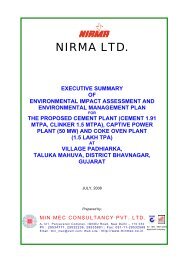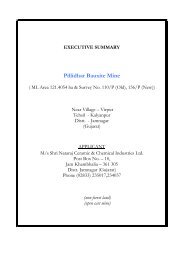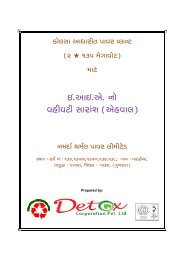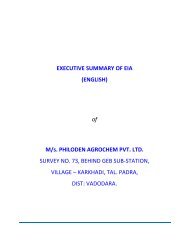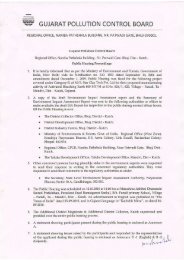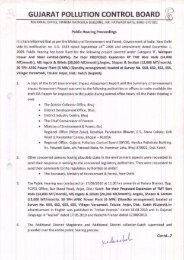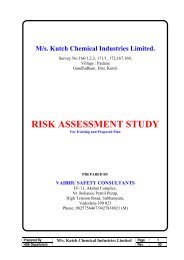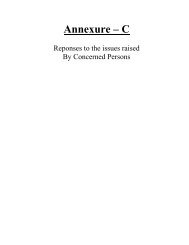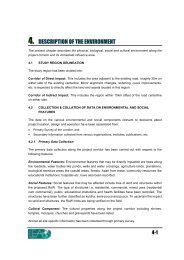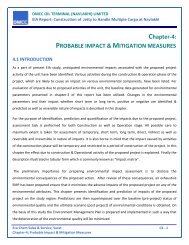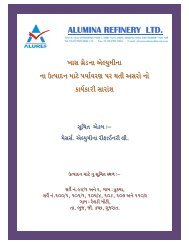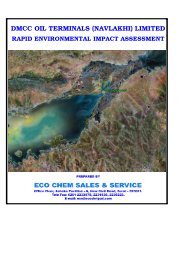1 of 13 - Gujarat Pollution Control Board
1 of 13 - Gujarat Pollution Control Board
1 of 13 - Gujarat Pollution Control Board
You also want an ePaper? Increase the reach of your titles
YUMPU automatically turns print PDFs into web optimized ePapers that Google loves.
Feasibility Study and Preparation <strong>of</strong> Detailed Project Report for 2-laning<br />
<strong>of</strong> Dahod Padholi section <strong>of</strong> NH 1<strong>13</strong> in the State <strong>of</strong> Rajasthan& <strong>Gujarat</strong><br />
1. PROJECT DESCRIPTION<br />
A) Introduction<br />
1 <strong>of</strong> <strong>13</strong><br />
Executive Summary<br />
The Govt. <strong>of</strong> India (GoI) through Ministry <strong>of</strong> Shipping, Road Transport & Highways (MOSRT&H) is<br />
contemplating to enhance the traffic capacity and safety for efficient transshipment <strong>of</strong> goods as<br />
well as passenger traffic on few <strong>of</strong> the selected corridors <strong>of</strong> National Highways.<br />
The existing project road is a 2-lane 7 m wide carriageway with/without shoulder width varying<br />
between 1-2 m on either side. Mostly shoulders are earthen/hard type.<br />
The NHAI has assigned LEA Associates South Asia Private Limited (LASA) to conduct Feasibility<br />
study and Preparation <strong>of</strong> Detailed Project Report and facilitate necessary clearances for the<br />
Project.<br />
Location<br />
The Project corridor includes the National Highway (NH-1<strong>13</strong>) stretch between Padi-Dahod in the<br />
state <strong>of</strong> Rajasthan and <strong>Gujarat</strong>. NH1<strong>13</strong> corridor passes through the districts Banswara (Rajasthan)<br />
& Dahod (<strong>Gujarat</strong>). The project road runs through three tehsils- Banswara, Bagidora & Sajjangarh<br />
in Banswara district & two tehsils- Jhalod & Dahod in Dahod district.<br />
The map showing the project corridor is presented in Figure 1.<br />
Existing RoW<br />
The existing RoW is 15m-25m along the project road. However, at certain existing realignment<br />
stretches, existing ROW <strong>of</strong> 33m-60m is also observed.<br />
B) Project Influence Area<br />
i) Direct Area <strong>of</strong> Influence<br />
The direct influence area <strong>of</strong> the project is restricted to proposed Right <strong>of</strong> Way (RoW) only, since<br />
the project involves widening <strong>of</strong> existing highway and all construction and operation stage activities<br />
will be contained with in it. The proposed RoW along the existing road stretch is mostly the existing<br />
ROW except at minor realignments in rural areas (45m) & bypass stretches (60m).<br />
ii) Indirect Area <strong>of</strong> Influence<br />
As per MoEF guidelines for conducting EIA (EIA notification, S O 1533 dated 14th Sept, 2006); the<br />
geographical scope <strong>of</strong> the EIA study has been considered as 15 km radius for highway projects for<br />
major environmental features like National Park, Wildlife Sanctuary, Critically Polluted Area,<br />
Notified Eco-Sensitive Zone, Inter-state Boundaries and International Boundaries (10 km), Coastal<br />
Zones, Areas protected under international conventions, defence installations etc. Physical<br />
features like physiography, hydrology were also studied/ recorded within 15 km radius <strong>of</strong> the<br />
project road.
Feasibility Study and Preparation <strong>of</strong> Detailed Project Report for 2-laning<br />
<strong>of</strong> Dahod Padholi section <strong>of</strong> NH 1<strong>13</strong> in the State <strong>of</strong> Rajasthan& <strong>Gujarat</strong><br />
C) Statutory Clearance Requirement<br />
Sl<br />
No<br />
Clearance Required for<br />
Figure 1: Location Map <strong>of</strong> the Project Corridor<br />
Table 1: Statutory Clearance Requirements<br />
Statute under which clearance is<br />
required<br />
1. Environmental Clearance EIA Notification, 2006 issued under<br />
EP Act, 1986<br />
2 <strong>of</strong> <strong>13</strong><br />
Executive Summary<br />
Statutory Authority<br />
Ministry <strong>of</strong> Environment and Forests,<br />
GOI, New Delhi
Feasibility Study and Preparation <strong>of</strong> Detailed Project Report for 2-laning<br />
<strong>of</strong> Dahod Padholi section <strong>of</strong> NH 1<strong>13</strong> in the State <strong>of</strong> Rajasthan& <strong>Gujarat</strong><br />
Sl<br />
Clearance Required for<br />
No<br />
2. Permission for felling <strong>of</strong> Roadside trees<br />
(non forest land)<br />
3. No Objection Certificate<br />
(Consent To Establish)<br />
Statute under which clearance is<br />
required<br />
3 <strong>of</strong> <strong>13</strong><br />
Executive Summary<br />
Statutory Authority<br />
Revenue Act Revenue Department<br />
Water (P&CP) Act, 1974 &<br />
Air (P&CP) Act, 1981<br />
4. Forest Clearance Forest<br />
1980<br />
Conservation Act<br />
D) Project Interventions<br />
State <strong>Pollution</strong> <strong>Control</strong><br />
<strong>Board</strong>.(Rajasthan)<br />
Rajasthan Forest Department<br />
The existing 7 m wide 2-lane carriageway shall be widened to 7 m wide carriageway with 1.5 m<br />
wide paved shoulder and 1.0 m earthen shoulder on either side <strong>of</strong> the carriageway for part <strong>of</strong> the<br />
project highway & 7m wide carriageway with 2.5m earthen shoulder on either side <strong>of</strong> the<br />
carriageway for rest <strong>of</strong> the project highway.<br />
Proposed features include 4 major bridges (2 bridges to be newly constructed), 29 minor bridges<br />
(11 retained, 1 widened, 12 newly constructed, 5 reconstructed), 1 Toll Plaza at km 240.5, Truck<br />
lay bye at 2 locations, 4 major realignments and 1 bypass.<br />
2. DESCRIPTION OF THE ENVIRONMENT<br />
A) Physical Environment<br />
(i) Climate and Meteorology<br />
The climate <strong>of</strong> Dahod district is characterized by a hot summer and dryness in the non-rainy<br />
seasons. The climate <strong>of</strong> district is usually hot. Maximum temperature is about 32°C and the<br />
minimum temperature is about 6.5°C. This district is considered as rain fed area. The average rain<br />
<strong>of</strong> district is 739 mm. Sometimes rain delays and district has to face drought. It’s very hot during<br />
March to June, while from November to February winter prevails in the district. Winds are<br />
generally light in the post monsoon and winter months and increase during summer and monsoon<br />
seasons. Banswara district has a climate which is very milder than that in the desert regions in<br />
further north and north-west with an average annual rainfall <strong>of</strong> 722 mm, the maximum being 1183<br />
mm. The minimum temperature in the district ranges between 10°C to 20°C and maximum<br />
between 35°C to 46°C.<br />
ii) Physiography and Terrain<br />
The project region forms a part <strong>of</strong> the eastern hilly tract covering parts <strong>of</strong> Jhalod and Dahod<br />
talukas. The Dahod district is a part <strong>of</strong> eastern hilly region. Banswara district forms the eastern<br />
part <strong>of</strong> the region known as Vagad or Vagwar. It has a rugged terrain undulated by short ridges<br />
west <strong>of</strong> Banswara town, while the eastern part is occupied by flat-topped hills <strong>of</strong> Deccan trap. It<br />
has the southern end <strong>of</strong> the Aravalli mountain ranges. The district lies in the Mahi river basin. The<br />
Mahi flows north through the district from its origin in the Vindhya Range <strong>of</strong> Madhya Pradesh,<br />
entering the district from the southeast and flowing north towards the northern end <strong>of</strong> the district,<br />
where it turns southwest to form the boundary between Banswara and Dungarpur districts before<br />
entering <strong>Gujarat</strong>. The western part <strong>of</strong> the district has a flat plain terrain.<br />
iii) Land Use
Feasibility Study and Preparation <strong>of</strong> Detailed Project Report for 2-laning<br />
<strong>of</strong> Dahod Padholi section <strong>of</strong> NH 1<strong>13</strong> in the State <strong>of</strong> Rajasthan& <strong>Gujarat</strong><br />
4 <strong>of</strong> <strong>13</strong><br />
Executive Summary<br />
A major part <strong>of</strong> the project corridor (start and end portions) runs through arable irrigated land, in<br />
the middle section the corridor runs through arable unirrigated land. A number <strong>of</strong> settlements are<br />
present along the road. The major settlements along the project corridor are Banswara, Jhalod<br />
and Dahod. It may be noted that dense settlements are proposed to be bypassed to minimize the<br />
displacement <strong>of</strong> the people. The project road runs mostly through rolling terrain.<br />
Forests are present along the project road. In the stretch <strong>of</strong> road in Banswara district (Rajasthan),<br />
reserve forest is present. In <strong>Gujarat</strong> stretch, the roadside trees are notified as Protected forest.<br />
iv) Water Resources<br />
Surface Water: Five major rivers flow through the region – the Panam, the Khan, the Kalutari, the<br />
Machhan and the Anas .The Khan river starts near the village in Dahod taluka. Banswara district<br />
lies in the Mahi river basin. The drainage system in Banswara district belongs to Mahi river which<br />
originates from Amjera hills near Dhar in Madhya Pradesh. Its main tributaries are Anas, Chanp,<br />
Erav, Haran and Kagdi.<br />
Rivers Anas, Machan & Kali cross the project road. The corridor runs mostly through rolling terrain.<br />
In stretches on plain terrain, irrigation facilities are available. In stretches on rolling terrain,<br />
irrigation is rain fed. A number <strong>of</strong> irrigation ducts have been observed along the project road.<br />
A number <strong>of</strong> cross drainages are present along the corridor. There are a number <strong>of</strong> nalas & rivers.<br />
Most <strong>of</strong> them are presently in dry condition. Besides these, check dams are also present.<br />
Ground Water: Ground water is the major source <strong>of</strong> irrigation in the project Districts. In Dahod<br />
District, water is found at shallow depth i.e. 40 to 50 mts. Irrigation takes place mainly by dug<br />
wells, tube wells/bore wells, tanks/ponds and canals. In Banswara District, the Mahi Bajaj Sagar<br />
Dam has been constructed on the Mahi river some 16 km away from Banswara town and helps in<br />
irrigation.<br />
(v) Water Quality<br />
Water quality monitoring stations for surface & ground water has been identified during the<br />
environmental screening study. The monitoring results are provided in Table 2: & 3 below :<br />
S. No Parameters Unit<br />
1.<br />
Temperature<br />
Table 2: Analysis <strong>of</strong> Ground Water<br />
Result<br />
GW1<br />
Davadia Village<br />
(°C)** 25.2<br />
Standards<br />
2. pH 6.79 6.5-8.5<br />
3. Dissolved Oxygen** (mg/l) 6.5 ------<br />
4. BOD, 3days at<br />
27 degree<br />
mg/l<br />
Feasibility Study and Preparation <strong>of</strong> Detailed Project Report for 2-laning<br />
<strong>of</strong> Dahod Padholi section <strong>of</strong> NH 1<strong>13</strong> in the State <strong>of</strong> Rajasthan& <strong>Gujarat</strong><br />
S. No Parameters Unit<br />
5 <strong>of</strong> <strong>13</strong><br />
Result<br />
GW1<br />
Davadia Village<br />
Standards<br />
10. Turbidity (NTU) 40.5 05<br />
11. Iron (mg/l) 0.151 0.3<br />
12. Arsenic (mg/l)
Monitoring<br />
Location &<br />
Code<br />
Hezamal<br />
Village (KM<br />
199/200)<br />
Khundani<br />
(KM 210)<br />
Davadia<br />
Village (KM<br />
226/300)<br />
Varod<br />
Village (KM<br />
238/400)<br />
Feasibility Study and Preparation <strong>of</strong> Detailed Project Report for 2-laning<br />
<strong>of</strong> Dahod Padholi section <strong>of</strong> NH 1<strong>13</strong> in the State <strong>of</strong> Rajasthan& <strong>Gujarat</strong><br />
6 <strong>of</strong> <strong>13</strong><br />
Executive Summary<br />
While comparing with the CPCB Norms for Surface Waters, all parameters are found to be within<br />
the standard limits except turbidity which is high and DO which is slightly above the desirable limit.<br />
Ground Water Quality Results: The ground water sample has been collected from hand pump.<br />
The pH value was found to be 6.79, generally within the permissible limits for drinking water. TDS<br />
value was 496.6 mg/l, lower than the permissible limit for drinking water (500 mg/l), total hardness<br />
is 230.7, lower than permissible limit. Chloride value was found to be 125.87 mg/l, iron content<br />
0.151 mg/l, thus within permissible limits. There is no significant bacteriological contamination <strong>of</strong><br />
these sources. Presence <strong>of</strong> heavy metals like arsenic, mercury, lead is insignificant.<br />
(vi) Air Quality<br />
Vehicles are the main source <strong>of</strong> air pollution along the project corridor. No large scale industrial<br />
activity is observed. Industrial area along the corridor falls between km 377/000- 377/100. The air<br />
quality along the corridor will be monitored to understand the ambient concentrations. Air quality<br />
monitoring stations are being identified along the corridor.<br />
A total <strong>of</strong> four (4) ambient air monitoring stations were identified based on the different existing<br />
land use pattern. Monitoring was carried out at a frequency <strong>of</strong> twice a week at each station<br />
adopting a 24 hour schedule. CO has been measured 8 hourly. The ambient air quality in the<br />
corridor was monitored with the ambient air quality norms stipulated by CPCB.<br />
Area<br />
Category<br />
Residential<br />
Residential<br />
Residential<br />
Residential<br />
PM -<br />
10<br />
µg/m<br />
3<br />
Table 4 Ambient Air Quality Monitoring Data<br />
Pollutant Concentration (µg/m 3 )<br />
24 hourly mean values<br />
PM -<br />
2.5<br />
µg/m3<br />
(SO2)<br />
µg/m3<br />
(NO2)<br />
µg/m3<br />
(O3)<br />
µg/m3<br />
46 <strong>13</strong>.3 10.1 15.4 29<br />
41 11.6 10.8 18.7 26<br />
46 14.2 <strong>13</strong>.3 26.1 26<br />
45 12.5 11.7 23.2 25<br />
(Pb)<br />
µg/m 3<br />
(CO)<br />
mg/m 3<br />
(NH3)<br />
µg/m 3<br />
(C6H6)<br />
µg/m 3<br />
(BaP)<br />
ng/m 3<br />
(As)<br />
ng/m 3<br />
(Ni)<br />
ng/m 3<br />
Feasibility Study and Preparation <strong>of</strong> Detailed Project Report for 2-laning<br />
<strong>of</strong> Dahod Padholi section <strong>of</strong> NH 1<strong>13</strong> in the State <strong>of</strong> Rajasthan& <strong>Gujarat</strong><br />
Sl.<br />
No.<br />
Location<br />
Area<br />
Category<br />
7 <strong>of</strong> <strong>13</strong><br />
Executive Summary<br />
Noise Levels, dB(A)<br />
Day Time<br />
Night Time<br />
(06:00-22:00 hrs.)<br />
(22:00-06:00 hrs.)<br />
Leq Day dB(A)<br />
Leq Night dB(A)<br />
NQ1 Settlement at Km 176/500 Residential 47.8 40.1<br />
NQ2 Settlement at Km 185/200 Residential 48.3 41.7<br />
NQ3 Davadia Viillage at Km 225/200 Residential 53.5 44.4<br />
NQ4 Hamirpura Viillage at Km 237/100 Residential 52.9 43.6<br />
Leq Norms* for Residential Areas 55 45<br />
Leq Norms* for Commercial Areas 65 55<br />
The Leq(day) varied between 47.8 dB(A) to 53.5 dB(A) in Residential Zone. The Leq(night) varied between 40.1<br />
dB(A) to 44.4 dB(A) in Residential Zone. Thus, ambient noise results at all the stations are within the<br />
permissible limit.<br />
B) Ecological Environment<br />
Forests<br />
Forests are present along the project road. The details <strong>of</strong> forest present along the project road<br />
have been detailed below. The road passes through Reserve & Protected forests. In Rajasthan,<br />
the road passes through Banswara forest division; in <strong>Gujarat</strong>, the road runs through Devgarh baria<br />
forest division. A total <strong>of</strong> 4.61ha <strong>of</strong> RF/PF is present in Rajasthan & 2.4 ha is present in <strong>Gujarat</strong><br />
along the Dahod bypass.<br />
(a) Reserve Forest<br />
Table 6: Forests along the Project Road (NH1<strong>13</strong>)<br />
Existing Km. Forest land width/area<br />
From To<br />
LHS<br />
(m)<br />
RHS<br />
(m)<br />
Area to be<br />
diverted(Sq.m)<br />
185.200 185.400 0.000 1.750 350.000<br />
186.200 186.300 2.750 0.000 275.000<br />
188.600 188.800 29.000 0.000 5800.000<br />
188.800 188.900 4.975 4.025 900.000<br />
188.900 189.000 0.000 4.025 402.500<br />
197.000 197.200 6.916 2.417 1866.600<br />
Forest type<br />
Degraded Open<br />
mix jungle; RF<br />
Name/ Category<br />
<strong>of</strong> Forest<br />
Nandor Mata RF<br />
Open jungle; RF Forest ( Budwa<br />
Hamirpura) RF<br />
Fairly dense<br />
Jungle RF<br />
Fairly dense<br />
Jungle RF<br />
Fairly dense<br />
Jungle RF<br />
Blank Forest area<br />
RF<br />
Forest (Gotia<br />
Amba Naal Dehri)<br />
RF<br />
Forest (Gotia<br />
Amba Naal Dehri)<br />
RF<br />
Forest (Gotia<br />
Amba Naal Dehri)<br />
RF<br />
Forest (Gotia<br />
Amba Naal Dehri)<br />
RF
Feasibility Study and Preparation <strong>of</strong> Detailed Project Report for 2-laning<br />
<strong>of</strong> Dahod Padholi section <strong>of</strong> NH 1<strong>13</strong> in the State <strong>of</strong> Rajasthan& <strong>Gujarat</strong><br />
Existing Km. Forest land width/area<br />
From To<br />
(b) Protected Forest<br />
LHS<br />
(m)<br />
RHS<br />
(m)<br />
Area to be<br />
diverted(Sq.m)<br />
197.200 197.400 0.000 1.583 316.600<br />
8 <strong>of</strong> <strong>13</strong><br />
Forest type<br />
Blank Forest area<br />
RF<br />
Name/ Category<br />
<strong>of</strong> Forest<br />
Forest (Gotia<br />
Amba Naal Dehri)<br />
RF<br />
198.000 198.200 6.346 0.321 <strong>13</strong>33.333 Blank forest RF Forest Jhumki RF<br />
211.600 212.100 4.500 4.500 4500.000<br />
212.100 212.150 4.900 4.100 450.000<br />
212.150 212.175 14.500 4.500 475.000<br />
212.175 212.400 29.000 0.000 6525.000<br />
Blank Forest RF Kundani Ganesh<br />
Pura RF<br />
Blank Forest RF Kundani Ganesh<br />
Pura RF<br />
Blank Forest RF Kundani Ganesh<br />
Pura RF<br />
Blank Forest RF Kundani Ganesh<br />
Pura RF<br />
212.700 212.900 0.000 14.424 2884.800 Blank Forest RF Forest Jhumki RF<br />
2<strong>13</strong>.700 2<strong>13</strong>.850 35.000 0.000 5250.000<br />
Total RF (Sq m) 3<strong>13</strong>28.833<br />
Total RF (ha) 3.<strong>13</strong>28<br />
Existing Km. Forest land width/area<br />
From To<br />
LHS<br />
(m)<br />
RHS<br />
(m)<br />
Area to be<br />
diverted(Sq.m)<br />
PF/Degraded Teak Forest Marh<br />
Anasphulwala RF<br />
Forest type<br />
Name/ Category<br />
<strong>of</strong> Forest<br />
216.600 216.700 0.000 3.000 300.000 Blank forest, PF Forest Dantla PF<br />
216.700 217.000 1.500 1.500 900.000 Blank forest, PF Forest Dantla PF<br />
217.000 217.200 1.250 4.250 1100.000 Blank forest, PF Forest Dantla PF<br />
217.200 217.400 5.500 0.500 1200.000 Blank forest, PF Forest Dantla PF<br />
217.400 217.600 5.834 2.834 1733.600 Blank forest, PF Forest Dantla PF<br />
217.600 217.800 5.724 1.610 1466.800 Blank forest, PF Forest Dantla PF<br />
217.800 218.300 6.036 0.000 3018.000<br />
218.300 218.350 4.750 0.250 250.000<br />
218.350 218.400 17.000 0.000 850.000<br />
Blank forest, PF Forest Bor Dabra<br />
PF<br />
PF/Degraded Teak Forest Mandok<br />
Chithatala PF<br />
PF/Degraded Teak Forest Mandok<br />
Chithatala PF<br />
Executive Summary
Feasibility Study and Preparation <strong>of</strong> Detailed Project Report for 2-laning<br />
<strong>of</strong> Dahod Padholi section <strong>of</strong> NH 1<strong>13</strong> in the State <strong>of</strong> Rajasthan& <strong>Gujarat</strong><br />
Existing Km. Forest land width/area<br />
From To<br />
LHS<br />
(m)<br />
RHS<br />
(m)<br />
Area to be<br />
diverted(Sq.m)<br />
218.400 218.500 14.500 14.500 2900.000<br />
218.700 218.900 0.000 5.750 1150.000<br />
Total PF (sq m) 14868.4<br />
Total PF (ha) 1.4868<br />
Forest area in Rajasthan: RF + PF= 3.<strong>13</strong> Ha + 1.48 Ha = 4.61 Ha.<br />
9 <strong>of</strong> <strong>13</strong><br />
Forest type<br />
Forest in <strong>Gujarat</strong> along the Dahod bypass: 400m length & 60 m width = 2.4 Ha<br />
Roadside Plantation<br />
Name/ Category<br />
<strong>of</strong> Forest<br />
PF/Degraded Teak Forest Shivpuri<br />
Sagan A PF<br />
Blank forest PF Forest Shivpuri<br />
Sagan A PF<br />
Executive Summary<br />
About 9278 trees are present along the existing road (within the proposed RoW). The predominant<br />
tree species include Babool & Mango. In <strong>Gujarat</strong> section <strong>of</strong> the project road, the roadside trees are<br />
notified as Protected forest.<br />
C) Cultural Environment<br />
A number <strong>of</strong> religious properties are present along the corridor. Most <strong>of</strong> them are temples. The<br />
important ones have been listed below.<br />
Table 7: Religious structures along the corridor (NH 1<strong>13</strong>)<br />
Sl. No.<br />
KM<br />
Chainage<br />
Name<br />
Side <strong>of</strong> Road<br />
(LHS/RHS)<br />
Distance<br />
from C/L(m)<br />
Length<br />
along<br />
Road<br />
1 180+800 Temple RHS 18 3<br />
2 202+500 Temple RHS <strong>13</strong> 15<br />
3 222+360 Temple RHS 6.8 4<br />
Remarks<br />
4 236+400 Temple RHS 25 3 Structure-25 m<br />
5 238+300 Temple RHS 23 2.5 Structure- 23 m<br />
6 240+350 Temple RHS 7 2<br />
7 240+900 Temple RHS 16 2<br />
8 245+500 Temple LHS 23 5 Structure at 23 m<br />
9 246+500<br />
Hanuman<br />
Temple LHS 7 2<br />
10 246+720 Temple LHS 27 2<br />
11 247+700 Temple LHS 10 25<br />
12 252+580 Temple RHS 10 5
Feasibility Study and Preparation <strong>of</strong> Detailed Project Report for 2-laning<br />
<strong>of</strong> Dahod Padholi section <strong>of</strong> NH 1<strong>13</strong> in the State <strong>of</strong> Rajasthan& <strong>Gujarat</strong><br />
Sl. No.<br />
KM<br />
Chainage<br />
Name<br />
Side <strong>of</strong> Road<br />
(LHS/RHS)<br />
10 <strong>of</strong> <strong>13</strong><br />
Distance<br />
from C/L(m)<br />
Length<br />
along<br />
Road<br />
<strong>13</strong> 252+350 Temple LHS <strong>13</strong> 4<br />
14 257+150 Temple RHS 18 4<br />
Executive Summary<br />
Remarks<br />
15 260+400 Temple LHS 18 3 Structure at 18 m<br />
16 262+400 Temple RHS 18 5<br />
17 262+400 Temple RHS 5<br />
A number <strong>of</strong> religious properties are present along the corridor. Most <strong>of</strong> them are temples. Along the project<br />
corridor NH 1<strong>13</strong>, 4 temples out <strong>of</strong> 17 cultural properties are being affected.<br />
3. ANTICIPATED ENVIRONMENTAL IMPACT AND MITIGATION MEASURES<br />
A) Anticipated Impacts<br />
The impacts <strong>of</strong> the project have been categorized into three phases: pre-construction, construction and<br />
operation phase.<br />
(i) Pre-construction Phase: Impacts during the preconstruction phase primarily relate to preconstruction<br />
activities such as diversion <strong>of</strong> Forest Land, Acquisition <strong>of</strong> new Right <strong>of</strong> Way and site clearance activities.<br />
There are number <strong>of</strong> amenities and utility services located along the highway such as restaurants, hand<br />
pumps, water taps, repair and spare parts shops, resting spaces, parking lots, PCOs, electric transformers,<br />
OFC etc. which will be impacted directly or indirectly due to widening <strong>of</strong> road.<br />
(ii) Construction Phase: Impacts during construction phase are primarily on account <strong>of</strong> negligence while<br />
undertaking the construction works. Impacts include nuisance on account <strong>of</strong> air, noise and vibration effects<br />
during road construction, hindrance to access <strong>of</strong> road side properties during shifting <strong>of</strong> utilities and<br />
construction <strong>of</strong> road side drains and road safety issues from construction materials and equipments.<br />
The microclimate is likely to be affected due to removal <strong>of</strong> some roadside trees and addition <strong>of</strong> increased<br />
pavement surface. The road widening will involve about 482055 cu m <strong>of</strong> cutting and 2<strong>13</strong>9092 cum <strong>of</strong> filling.<br />
The acquisition <strong>of</strong> agricultural land would cause loss <strong>of</strong> productive soil. All bridge locations where elevated<br />
embankments are required would be more sensitive to erosion during the construction period. Spillage <strong>of</strong><br />
construction materials like bitumen, asphalt, oil & grease etc. and the unwarranted disposal <strong>of</strong> construction<br />
spoils and debris will affect the core characteristics <strong>of</strong> the soil, which in turn can become unsuitable for<br />
agriculture. Aggregate and sand shall be procured from the licensed sources. Earth shall be collected from<br />
nearby borrow areas as suitable. These sites and haul roads will have impact in terms <strong>of</strong> dust and noise.<br />
During construction, the disposal <strong>of</strong> solid and liquid waste from labour camps, fuel and lubricant spills or<br />
leaks from construction vehicles, pollution from fuel storage & distribution sites is likely to affect water<br />
quality. The negative impacts on air quality during construction will be mostly localized and concentrated in<br />
the Right <strong>of</strong> Way (RoW)/COI. However, it is likely that impacts due to dust generation are likely to be felt<br />
downwind <strong>of</strong> the site rather than the site itself. The noise levels in the project area during construction will<br />
increase though it will be intermittent and temporary in nature. The noise levels will be more pronounced<br />
around settlements and in inhabited areas. Most <strong>of</strong> the religious structures will remain unaffected due to<br />
widening. Only 3 medium sized temples & a few shrines will be affected. Two schools will be partially<br />
affected. Sewage and domestic solid waste will be generated at the construction workers colony. Improper<br />
management <strong>of</strong> these wastes may lead to health and hygiene related problems among the construction<br />
workers and the local population.
Feasibility Study and Preparation <strong>of</strong> Detailed Project Report for 2-laning<br />
<strong>of</strong> Dahod Padholi section <strong>of</strong> NH 1<strong>13</strong> in the State <strong>of</strong> Rajasthan& <strong>Gujarat</strong><br />
11 <strong>of</strong> <strong>13</strong><br />
Executive Summary<br />
(iii) Operation Phase: Soil pollution due to accidental vehicle spills or leaks is a low probability but<br />
potentially disastrous to the receiving environment, if they occur. These impacts can be a long term and<br />
irreversible depending upon the extent and type <strong>of</strong> spill. Pollutants from vehicles, and accidental fuel spills<br />
may also make their way into surface water bodies across/along the project corridor. Higher traffic volume<br />
and speed will have impact on the ambient air quality. Increase in the number <strong>of</strong> vehicles would increase the<br />
pollutant load. Higher noise levels due to increased traffic volume and speed will affect the residential areas<br />
and sensitive receptor like educational institutes.<br />
B) Environmental Mitigation Measures<br />
(i) Pre-construction Phase: Widening option has been selected as concentric except hilly stretches where<br />
widening is proposed on hill side. Realignments are proposed for correction <strong>of</strong> geometry and it will enhance<br />
Road safety for the user <strong>of</strong> the corridor. As a part <strong>of</strong> the compensatory plantation at least 2 trees shall be<br />
planted for each tree cut. Net Present Value shall be deposited to the Forest Department for diversion <strong>of</strong><br />
Forests as per demand note <strong>of</strong> the forest department. Compensation shall be paid for acquisition <strong>of</strong> land<br />
structures as per the Entitlement matrix developed for the project subject to recommendation by the Special<br />
Land Acquisition Officer. The amenities like hand pumps, water tap, tube wells etc. and cultural resources<br />
viz temples, schools etc. which comes under direct impact will be compensated and relocated with<br />
community consultation and others will be shifted as per resettlement action plan.<br />
(ii) Construction Phase:<br />
Cut and fill is being balanced in the design to the extent feasible to minimize impacts on the physiography <strong>of</strong><br />
the region. Aggregates will be sourced only from the licensed quarry sites, complying with the environmental<br />
and other applicable regulations. Rehabilitation <strong>of</strong> borrow pits and quarry areas shall be carried out in an<br />
environment friendly manner. Similarly, fresh embankment created at the site shall be covered with dredged<br />
earth for turfing <strong>of</strong> slope in order to prevent soil erosion. Top soil shall be stripped up to a depth <strong>of</strong> 15 cm<br />
and stripped top soil shall be stock piled at suitable location and shall be used wisely. Plants viz. Hot Mix<br />
Plant, D G Sets, Batching Plant, Crusher etc. shall be located at down stream direction to the habitations, if<br />
any and EMP guidelines shall be followed. Water shall be sprinkled at the haul roads, plant sites and<br />
construction sites as per requirement. Construction vehicles, equipments and plants shall strictly adhere to<br />
permissible noise standard during construction period. All necessary and adequate care has been taken to<br />
minimize impact on cultural properties (which includes Temples, places <strong>of</strong> worship, Majar, & others). Silt<br />
fencing and or brush barrier shall be installed for collecting sediments before letting them into the surface<br />
water bodies.<br />
NHAI shall pay the Net Present Value <strong>of</strong> the forest land to be diverted for the project. A Compensatory<br />
Afforestation programme shall be undertaken by the Forest Department at least double the quantum <strong>of</strong><br />
forest land to be diverted. Compensatory plantation shall be carried out as part <strong>of</strong> the project to minimize the<br />
proposed loss <strong>of</strong> green cover along the corridor due to cutting <strong>of</strong> road side trees.<br />
Disposal <strong>of</strong> construction waste shall be undertaken at landfill sites to minimize impacts. If a spillage occurs,<br />
measures for safe incineration <strong>of</strong> spilled oil shall be taken to prevent seepage into the ground. To avoid<br />
contamination <strong>of</strong> the water bodies and drainage channels from fuel and lubricants, oil interceptor shall be<br />
provided at re-fuelling locations, construction vehicle parking area, vehicle repair area and workshops. The<br />
sewage system (including septic tanks and soak pits) for construction camps will be properly designed and<br />
built so that no water pollution takes place in any water body or watercourse.<br />
(iii) Operation Phase<br />
Widening <strong>of</strong> existing road to 2-lane facility with paved shoulders will reduce the traffic congestion.<br />
Smoothening <strong>of</strong> road surface shall further reduce the emission <strong>of</strong> the vehicles and noise level. Growth <strong>of</strong> the
Feasibility Study and Preparation <strong>of</strong> Detailed Project Report for 2-laning<br />
<strong>of</strong> Dahod Padholi section <strong>of</strong> NH 1<strong>13</strong> in the State <strong>of</strong> Rajasthan& <strong>Gujarat</strong><br />
12 <strong>of</strong> <strong>13</strong><br />
Executive Summary<br />
vegetative cover along the corridor with time shall again reduce impact <strong>of</strong> the air pollution. Plantation <strong>of</strong><br />
green vegetative noise barriers have been proposed in front <strong>of</strong> the schools depending on the space<br />
available. These will reduce noise level. Air quality and noise level monitoring shall be conducted as per<br />
monitoring plan during operation phase <strong>of</strong> the project to confirm whether further mitigation measures<br />
required.<br />
4. ENVIRONMENTAL MONITORING PROGRAMME<br />
Provisions have been made for monitoring <strong>of</strong> environmental attributes during construction and operation<br />
phase <strong>of</strong> the project. The details <strong>of</strong> the parameters, frequency and duration are given in Table 7.<br />
Attribute<br />
Air<br />
Project<br />
Stage<br />
Construction<br />
Operation<br />
Water Construction<br />
Noise<br />
Table 8: Details <strong>of</strong> Environmental Monitoring<br />
Parameter Frequency Duration Location<br />
RPM 10µm, RPM 2.5µm, SO 2,<br />
NO X, CO & Pb.<br />
RPM 10µm, RPM 2.5µm, SO 2,<br />
NOx, CO & Pb.<br />
(i) pH, BOD,COD, TDS, Pb,<br />
Oil & Grease and<br />
Detergents<br />
Water.<br />
for Surface<br />
(ii) pH, TDS, Total<br />
Hardness, Sulphate,<br />
Chloride, Fe, Pb for<br />
Ground Water<br />
Noise levels on dB (A)<br />
scale<br />
Construction<br />
Noise levels on dB (A)<br />
scale<br />
Operation Noise levels on dB (A)<br />
scale<br />
5. PROJECT BENEFIT<br />
Once every<br />
season for three<br />
seasons (except<br />
monsoons) per<br />
year for each year<br />
<strong>of</strong> Construction<br />
Once every year for<br />
winter season for<br />
five years after<br />
completion<br />
construction<br />
activity.<br />
<strong>of</strong><br />
Twice a year (Pre<br />
monsoon and Post<br />
monsoon seasons)<br />
for each year during<br />
the<br />
Period<br />
Construction<br />
Once every season<br />
(except monsoons)<br />
for each year <strong>of</strong><br />
Construction<br />
Once every season<br />
(except monsoons)<br />
for each year <strong>of</strong><br />
Construction<br />
Once every season<br />
(except monsoons)<br />
for five year after<br />
completion <strong>of</strong><br />
construction<br />
activity.<br />
Continuous 24 hours/<br />
or for 1 full working day<br />
4 Locations (hot<br />
mix plant and 3<br />
locations along the<br />
corridor)<br />
Continuous 24 hours 3 locations along<br />
the corridor<br />
Grab Sampling<br />
Readings to be taken at<br />
15 seconds interval for 15<br />
minutes every hour and<br />
then averaged.<br />
Readings to be taken at<br />
15 seconds interval for 15<br />
minutes every hour and<br />
then averaged.<br />
Readings to be taken at<br />
15 seconds interval for 15<br />
minutes every hour and<br />
then averaged.<br />
3 locations (three<br />
surface water)<br />
5 locations at plant<br />
and equipment sites<br />
3 locations along<br />
the corridor<br />
3 locations along<br />
the corridor<br />
Implementation <strong>of</strong> the Project will have following benefits:<br />
� To accelerate regional economic development in terms <strong>of</strong> industry, tourism and agriculture,<br />
� To reduce vehicle operating and maintenance costs by improving road conditions,<br />
� To reduce travel time by minimizing congestion in urban stretches and providing a four lane facility over there,<br />
� To minimize road accidents by increasing road widths, improving intersections and road geometry,
Feasibility Study and Preparation <strong>of</strong> Detailed Project Report for 2-laning<br />
<strong>of</strong> Dahod Padholi section <strong>of</strong> NH 1<strong>13</strong> in the State <strong>of</strong> Rajasthan& <strong>Gujarat</strong><br />
<strong>13</strong> <strong>of</strong> <strong>13</strong><br />
Executive Summary<br />
� The project may also generate local employment opportunities through the construction activities and local<br />
business.<br />
� Abatement <strong>of</strong> ambient air and noise pollution in comparison to a do-nothing situation.<br />
� Increase in safety due to construction <strong>of</strong> median in urban sections between two directions <strong>of</strong> traffic flow.<br />
� Construction <strong>of</strong> Road Over Bridge (ROBs) shall reduce travel time and enhance smooth flow <strong>of</strong> the traffic<br />
� Project facilities included in the project preparation are Bus Bays, Truck Lay Bye, Road/Street Lighting etc.<br />
6. ENVIRONMENTAL MANAGEMENT PLAN<br />
Several mitigation measures have been suggested along with the agency responsible for planning,<br />
execution, supervision and monitoring <strong>of</strong> the Environment Management Plan for pre-construction,<br />
construction and operation stages to avoid or mitigate the adverse impacts.<br />
a) Pre-construction Phase<br />
Pre-construction activities include acquisition <strong>of</strong> land and structures, relocation <strong>of</strong> utilities, removal <strong>of</strong> trees,<br />
relocation <strong>of</strong> community property resources viz. temple, obtaining environmental clearances from MoEF,<br />
New Delhi, Forest Clearance from regional <strong>of</strong>fice <strong>of</strong> MoEF, Consent To Establish from Rajasthan State<br />
<strong>Pollution</strong> <strong>Control</strong> <strong>Board</strong>, NHAI and concerned departments shall be responsible for those activities.<br />
b) Construction Phase<br />
Activities during this phase shall include setting up <strong>of</strong> Construction Camp, setting up <strong>of</strong> plants namely<br />
crusher plant, concrete batching plant, hot mix plant; clearing and grubbing, collection, storage and<br />
utilization <strong>of</strong> topsoil, identification <strong>of</strong> borrow pit & aggregate quarry (if other than those identified by design<br />
consultant), operation <strong>of</strong> the quarry, plantation along the road side, environmental protection & monitoring.<br />
Contractor shall be responsible for obtaining “consent to establish” and “operate” <strong>of</strong> those plants. Contractor<br />
shall also be responsible for implementation <strong>of</strong> the environmental protection measures during construction<br />
phase. NHAI and NHAI’s Supervision Consultant shall be responsible for monitoring & supervision <strong>of</strong> the<br />
Contractor’s activities as per Contract & Supervision Consultant shall report it to PIU, NHAI time to time.<br />
Project Implementation Unit (PIU), NHAI shall be responsible for regulatory compliance.<br />
c) Operation Phase<br />
Operation phase activities include environmental monitoring and to ensure survival rate <strong>of</strong> the plantation etc.<br />
The PIU shall be responsible for those activities.<br />
d) Environmental costs<br />
The costs for mitigation and management measures have been estimated for inclusion into the Economic<br />
Analysis. These costs along with the social costs have to be incurred by the implementing agency to include<br />
environmental and social safeguard measures into the proposed project. However, the environmental cost<br />
estimates are presented in the following Table.<br />
Table 9: Environmental costs<br />
Sl No Budget Head Cost in Million (INR)<br />
1. <strong>Pollution</strong> <strong>Control</strong> 8.96<br />
2. Monitoring Costs 19.332<br />
3. Green Belt & Forest Diversion 36.770<br />
Total 56.998
JCLJ8L ;FZF\X<br />
ZFH:YFG VG[ U]HZFT ZFHIMDF\ ZFQ8=LI WMZL DFU" !!# GF NFCMN v<br />
5-M,L lJEFUGF äL5Y DFU" DF8[GM lJUTJFZ 5|MH[S8 VC[JF, TYF XSITF<br />
VeIF; T{IFZ SZJMP<br />
!P 5|MH[S8G]\ J6"G<br />
sSf 5|:TFJGF<br />
EFZT ;ZSFZ T[GF H/ DFU"4 DFU" 5lZJCG VG[ WMZLDFU" D\+F,I äFZF<br />
ZFQ8=LI WMZL DFU"GF 5;\N SZ[,F S[8,FS SMZL0MZ 5Z DF,;FDFG T[DH<br />
D];FOZLGL C[ZO[ZGF SFI"1FD JFCGvAN,L DF8[ C[ZO[Z 1FDTF VG[ ;,FDTLDF\<br />
JWFZM SZJF V5[1FF ZFB[ K[P<br />
CF,GM 5|MH[S8 DFU" A\G[ AFH]V[ !vZ DL8Z JW38 YTL 5CM/F. ;FY[ S[<br />
lJGF4 * DL8Z 5CM/M äL5Y JFCG DFU" K[P DM8FEFUGF XM
+6 TF,]SF v JF\;JF0F4 AFUL0MZF VG[ ;HHGU- VG[ NFCMN lH
TF,]SF o<br />
5|MH[S8 SMZL0MZGL AFH]GF\<br />
VFS'lTv! o 5|MH[S8 SMZL0MZGM :Y/ GSXM<br />
3
sUf SFG}GL D\H}ZLGL H~lZIFT<br />
S|D v G[ DF8[ H~ZL<br />
D\H}ZL<br />
! 5IF"JZ6 lJQFIS<br />
D\H}ZL<br />
Z DFU"GL AFH]GF\<br />
J'1FM slAG JG<br />
lJ:TFZf SF-JF<br />
# GFvJF\WF<br />
5|DF65+<br />
s:YF5JFGL<br />
;\DlTf<br />
SM9Mv! o SFG}GL D\H}ZLGL H~lZIFTM<br />
SIF SFINF C[9/ D\H}ZL H~ZL K[ SFG}GL T\+<br />
EP, Environment<br />
protection, 5IF"JZ6 ;\Z1F6<br />
VlWlGID4 !)(& C[9/ SF-[,<br />
EIA HFC[ZGFD]\4 Z__&<br />
4<br />
5IF"JZ6 VG[ JG<br />
D\+F,I4 EFZT<br />
;ZSFZ4 GJL lN
5|MH[S8GL ;]lRT lJlXQ8TFVMDF\ $ D]bI 5},M sZ GJF AF\WJFGF 5},Mf4<br />
Z) GFGF 5},M s!! J5ZFXDF\ RF,] ZFBJF4 ! 5CM/M SZJFGM4 !Z GJF<br />
AF\WJFGF4 5 5]Go lGDF"6 SZJFGFf4 Z$_P5 DF\ SLPDLP V[ ! 8M, %,FhF4 Z<br />
:Y/MV[ 8=S ,[vAFI4 $ HuIFV[ ,F.G NMZLDF\ DM8L O[ZAN, VG[ ! AFZMAFZ<br />
ACFZ GLS/JFGF DFU"GM ;DFJ[X YFI K[P<br />
ZP 5IF"JZ6G]\ J6"G<br />
sSf EF{lTS 5IF"JZ6<br />
s!f VFAMCJF VG[ CJFDFGXF:+<br />
NFCMN lH
;F\S0L 0]\UZ 8MR JF/M pA0 BFA0 BZAR0F E}5|N[XJF/M JF\;JF0F GUZGM<br />
5lüD EFU K[4 HIFZ[ 5}JL"I EFU ;5F8 8MRJF/F 0[SSG 8=[5 0]\UZF/ 5|N[XYL<br />
KJFI[,M K[P T[DF\ VZJ
VGF;4 DFK6 VG[ SF,L GNLVM 5|MH[S8 DFU" VM/\U[ K[P SMZL0MZ DCN<br />
V\X[ ,F\AF -F/JF/F E}5|N[XDF\YL 5;FZ YFI K[P ;5F8 E}5|N[X lJ:TFZDF\<br />
l;\RF.GL ;UJ0M p5,aW K[P ,F\AF -F/JF/F E}5|N[X lJ:TFZDF\ l;\RF. JZ;FN<br />
5Z VFWFlZT K[P ;\bIFA\W l;\RF.GL JFCSG/LVM 5|MH[S8 DFU"GL VF;5F; HMJF<br />
D/[ K[P<br />
SMZL0MZGL VF;5F; ;\bIFA\W VF0L DMZLVM CFHZ K[P tIF\ ;\bIFA\W<br />
GF/F\ VG[ GNLVM K[P T[DF\GF\ DM8FEFUGF\ CF, ;}SF. UI[, l:YlTDF\ K[P VF<br />
p5ZF\T VF0A\WM 56 DMH}N K[P<br />
E}UE" H/o 5|MH[S8 lH
S|D 5FZlDlTVM V[SD 5lZ6FD<br />
GW1<br />
N[Jl0IF UFD<br />
8<br />
WMZ6M<br />
5 S], ;BT56] (mg/l) Z#_P* #__<br />
& S], VMU/[, 3G (mg/l) $)&P& 5__<br />
* CI TZLS[ S,MZF.0 (mg/l) !Z5P(* v<br />
( SO4 TZLS[ ;
S|D 5FZlDlTVM V[SD 5lZ6FDM ;L5L;LAL<br />
AMA["8 5}, VGF; 5}, DFK6 0[D WMZ6M 2<br />
s!$*q___f sZ$!q___f sZ$_q!__f<br />
$ BOD 27<br />
l0U|LV[ #<br />
lNJ;<br />
(mg/l)
5M8["A, JM8Z V[GFl,;L; SL8 sV[l,SM DM0[, !#&f GM p5IMU SZL GD]GF ,[TL<br />
JBT[ DF5JFDF\ VFJL CTLP ZF;FIl6S 5'YSSZ6 DF8[ GD}GF IS:2488 DF\ lGIT<br />
SIF" 5|DF6[GL SFI" 5wWlT 5|DF6[ ,[JFDF\ VFjIF CTFP<br />
;5F8L 5ZGF 5F6LGL U]6J¿F 5lZ6FDMo pH D}
N[BZ[B<br />
lGI\+6 :Y/<br />
VG[ SM0<br />
C[hFD, UFD<br />
sSLPDLP<br />
!))qZ__f<br />
B]\N6L<br />
sSLPDLPZ!_f<br />
N[Jl0IF UFD<br />
sSLPDLP<br />
ZZ&q#__f<br />
JFZM0 UFD<br />
sSLPDLP<br />
Z#_q$__f<br />
lJ:TFZ<br />
5|SFZ<br />
s&f CJFGL U]6J¿F<br />
5|MH[S8 lJ:TFZGL VF;5F;GF\ JFCGM CJFGF 5|N}QF6G]\ D]bI ;FWG K[P<br />
DM8F 5FIFGL SM. VF{nMlUS 5|J'l¿ §xIDFG YI[, GYLP SMZL0MZGF #**q___ v<br />
#**q!__ SLPDLP JrR[ VF{nMlUS lJ:TFZ K[P 5ZL;ZG]\ S[g LSZ6 ;DHJF<br />
SMZL0MZGL VF;5F; CJFGL U]6J¿FG]\ N[BZ[B lGI\+6 SZJFDF\ VFJX[P<br />
SMZL0MZGL ,\AF.JFZ CJF U]6J¿F DF5S S[g§M GSSL SZJFDF\ VFJL Z F K[P<br />
N[BZ[B lGI\+6GF\ S], $ DYSM CF,GF HDLG J5ZFXGL GSXL VFWFlZT<br />
GSSL SZJFDF\ VFjIF\ K[P Z$ S,FSGF ;DI5+S 5|DF6[ NZ[S DYS[ V9JFl0IFDF\<br />
A[JFZ N[BZ[B lGI\+6 SZJFDF\ VFjI]\ CT]\P ;LPVMPGL DF56L NZ ( S,FS[<br />
SZJFDF\ VFJ[, CTLP SMZL0MZ VF;5F;GL CJFGL U]6J¿F ;L5L;LAL wJFZF<br />
9ZFJ[, VF;5F;GL CJF U]6J¿F WMZ6M ;FD[ N[BZ[B lGI\+6 SZJFDF\ VFjI]\<br />
CT]\P<br />
PM<br />
SM9Mv$ VF;5F;GL CJF U]6J¿F N[BZ[B lGI\+6 DFlCTL<br />
PM 2.5<br />
3<br />
(SO2)<br />
3<br />
3<br />
� g / m � g / m � g / m � g / m � g / m<br />
5|N}QF6 S[gN=LSZ6 (Mg/m 3 ) Z$ S,FS ;Z[ZFX D}
s*f VJFHGL U]6J¿F<br />
VeIF;1F[+DF\ 5'Q9 E}lD VJFHGL S1FFGM V\NFH SF-JF4 VF;5F;GF<br />
VJFHG]\ N[BZ[B lGI\+6 CFY WZJFDF\ VFjI]\ CT]\P H]NL H]NL S1FFGF lJ:TFZ<br />
VFWFlZT 5|MH[S8 DFU"GL VFH]AFH]GF\ S], $ :Y/M GSSL SZJFDF\ VFjIF\ CTF\P<br />
SM9Mv5 SMZL0MZ VFH]AFH]GF VJFHGL S1FF<br />
S|D :Y/ lJ:TFZ<br />
S1FF<br />
NQ1 !*&q5__ SLPDLPGM<br />
J;JF8<br />
NQ2 !(5qZ__ SLPDLPGM<br />
J;JF8<br />
NQ3 ZZ5qZ__ N[Jl0IF<br />
UFD[<br />
NQ4 Z#*q!__<br />
CDLZ5]ZF UFD[<br />
12<br />
VJFHGL S1FFdB(A)<br />
lNJ;GM ;DI<br />
_P&vZZv__<br />
S,FS<br />
Leq lNJ;<br />
dB(A)<br />
ZFl+GM ;DI<br />
ZZP__v<br />
_&P__ S,FS<br />
Leq ZFl+<br />
dB(A)<br />
ZC[6F\S $*P( $_P!<br />
ZC[6F\S $(P# $!P*<br />
ZC[6F\S 5#P5 $$P$<br />
ZC[6F\S 5ZP) $#P&<br />
ZC[6F\S lJ:TFZ DF8[ Leq WMZ6M 55 $5<br />
JFl6lHIS lJ:TFZ DF8[Leq WMZ6M &5 55<br />
ZC[6F\S lJ:TFZDF\ Leq slNJ;[f $*P(dB(A) YL 5#P5 dB(A) JrR[<br />
JW38 Y.P ZC[6FS lJ:TFZDF\ Leq sZFl+f V[ $_P! dB(A) YL $$P$<br />
dB(A) JrR[ JW38 Y.P VFD VF;5F;GF lJ:TFZDF\ TDFD DYSMV[ VJFHGL<br />
S1FFGF\ 5lZ6FDM :JLSFI" DIF"NFDF\ K[P
sBf 5lZl:YlT lJQFIS 5IF"JZ6<br />
JG<br />
5|MH[S8 DFU"GL ,\AF.JFZ JGM VFJ[,F\ K[P 5|MH[S8 DFU"GL ,\AF.JFZ<br />
VFJ[, JGGL lJUTM GLR[ VF5L K[P 5|MH[S8 DFU" Zl1FT VG[ VGFDT JGMDF\YL<br />
5;FZ YFI K[P ZFH:YFGDF\ 5|MH[S8 DFU" JF\;JF0F JG lJEFUDF\YL 5;FZ YFI<br />
K[P U]HZFTDF\ N[JU-AFlZIF JG lJEFUDF\YL DFU" 5;FZ YFI K[P ZFH:YFGDF\<br />
Zl1FT q VGFDT JG lJ:TFZ S], $P&! C[P K[ VG[ U]HZFTDF\ T[ ZP$ C[P NFCMN<br />
p5DFU"GL AFH]DF\ K[P<br />
sSf VGFDT JG<br />
SM9Mv& 5|MH[S8 DFU"GL VF;5F; JG sZFPWMP !!#f<br />
CF,GF SLPDLP JG HDLGGL 5CM/F.qlJ:TFZ JGGM 5|SFZ JGG]\ GFDqS1FF<br />
SIF\YL SIF\ LHSsDLf RHSsDLf O\8FJFGM lJ:TFZ<br />
sRMPSLPDLPf<br />
!(5PZ__ !(5P$__ _P___ !P*5_ #5_P__ 5F\B] B]
CF,GF SLPDLP JG HDLGGL 5CM/F.qlJ:TFZ JGGM 5|SFZ JGG]\ GFDqS1FF<br />
SIF\YL SIF\ LHSsDLf RHSsDLf O\8FJFGM lJ:TFZ<br />
sRMPSLPDLPf<br />
Z!ZP!__ Z!ZP!5_ $P)__ $P!__ $5_P___ ;]SM JG lJ:TFZ<br />
VGFDT<br />
Z!ZP!5_ Z!ZP!*5 !$P5__ $P5__ $*5P___ ;]SM JG lJ:TFZ<br />
VGFDT<br />
Z!ZP!*5 Z!ZP$__ Z)P___ _P___ &5Z5P___ ;]SM JG lJ:TFZ<br />
VGFDT<br />
Z!ZP*__ Z!ZP)__ _P___ !$P$Z$ Z(($P(__ ;]SM JG lJ:TFZ<br />
VGFDT<br />
Z!#P*__ Z!#P(5_ #5P___ _P___ 5Z5_P__ Zl1FT JGq 5F\BF<br />
;FU J'1FM<br />
sAf Zl1FT JG<br />
S], VGFDT JG sRMPDLPf #!#Z(P(##<br />
S], VGFDT sC[f #P!#Z(<br />
14<br />
S]\0F6L U6[X5]ZF<br />
VGFDT JG<br />
S]\0F6L U6[X5]ZF<br />
VGFDT JG<br />
S]\0F6L U6[X5]ZF<br />
VGFDT JG<br />
JG h]DSL VGFDT JG<br />
JG DFC"<br />
VGF;O],JF,F<br />
VGFDT JG<br />
CF,GF SLPDLP JG HDLGGL 5CM/F.qlJ:TFZ JGGM 5|SFZ JGG]\ GFDqS1FF<br />
SIF\YL SIF\ LHSsDLf RHSsDLf O\8FJFGM lJ:TFZ<br />
sRMPSLPDLPf<br />
Z!&P&__ Z!&P*__ _P___ #P___ #__P__ ;}S]\ JG Zl1FT<br />
JG<br />
Z!&P*__ Z!*P___ !P5__ !P5__ )__P___ ;}S]\ JG Zl1FT<br />
JG<br />
Z!*P___ Z!*PZ__ !PZ5_ $PZ5_ !!__P__ ;}S]\ JG Zl1FT<br />
JG<br />
Z!*PZ__ Z!*P$__ 5P5__ _P5__ !Z__P___ ;}S]\ JG Zl1FT<br />
JG<br />
Z!*P$__ Z!*P&__ 5P(#$ ZP(#$ !*##P&__ ;}S]\ JG Zl1FT<br />
JG<br />
Z!*P&__ Z!*P(__ 5P*Z$ !P&!_ !$&&P(__ ;}S]\ JG Zl1FT<br />
JG<br />
Z!*P(__ Z!(P#__ &P_#& _P___ #_!(P___ ;}S]\ JG Zl1FT<br />
JG<br />
Z!(P#__ Z!(P#5_ $P*5_ _PZ5_ Z5_P___ Zl1FT JGq 5F\BF<br />
;FU J'1FM<br />
Z!(P#5_ Z!(P$__ !*P___ _P___ (5_P___ Zl1FT JGq 5F\BF<br />
;FU J'1FM<br />
JG NF\T,F Zl1FT<br />
JG<br />
JG NF\T,F Zl1FT<br />
JG<br />
JG NF\T,F Zl1FT<br />
JG<br />
JG NF\T,F Zl1FT<br />
JG<br />
JG NF\T,F Zl1FT<br />
JG<br />
JG NF\T,F Zl1FT<br />
JG<br />
JG AMZ 0FAZF<br />
Zl1FT JG<br />
JG DF\0MS RLYT,F<br />
Zl1FT JG<br />
JG DF\0MS RLYT,F<br />
Zl1FT JG
CF,GF SLPDLP JG HDLGGL 5CM/F.qlJ:TFZ JGGM 5|SFZ JGG]\ GFDqS1FF<br />
SIF\YL SIF\ LHSsDLf RHSsDLf O\8FJFGM lJ:TFZ<br />
sRMPSLPDLPf<br />
Z!(P$__ Z!(P5__ !$P5__ !$P5__ Z)__P___ Zl1FT JGq 5F\BF<br />
;FU J'1FM<br />
Z!(P*__ Z!(P)__ _P___ 5P*5_ !!5_P___ ;]S]= JG Zl1FT<br />
JG<br />
S], VGFDT JG sRMPDLPf !$(&(P$<br />
S], VGFDT sC[f !P$(&(<br />
15<br />
JG lXJ5]ZL ;FUG<br />
Zl1FT JG<br />
JG lXJ5]ZL ;FUG<br />
Zl1FT JG<br />
ZFH:YFGDF\ JG lJ:TFZ o VPJP´ZPJP ov #P!# C[P ´ !P$( C[P ov $P&! C[P<br />
U]HZFTDF\ NFCMN AFZMAFZ ACFZ HTF DFU"GL VF;5F; JGo $__ lDP,\AF.<br />
VG[ &_ lDP 5CM/F. ov ZP$ C[P<br />
DFU"GL AFH]DF\ JFJ[TZ<br />
CF,GF DFU" s;}lRT DFUF"lWSFZGL V\NZf GL VF;5F; VFXZ[ )4Z*(<br />
J'1FM DMH}N K[P 5|FWFgI56[ J'1FMGL HFlTVMDF\ AFJ/ VG[ VF\AFGM ;DFJ[X YFI<br />
K[P 5|MH[S8 DFU"GF U]HZFT lJEFUDF\ DFU"GL AFH]GF\ J'1FMG[ Zl1FT JG TZLS[<br />
lGlN"Q8 SZFIF\ K[P<br />
sUf ;F\:S'lTS 5IF"JZ6<br />
SMZL0MZGL VFH]AFH] ;\bIFA\W WFlD"S lD,STM VFJ[,L K[P T[DF\ DM8F<br />
EFUGF D\lNZM K[P T[DF\GF DCtJGF\ D\lNZMGL IFNL GLR[ VF5L K[P<br />
SM9Mv* o SMZL0MZ VF;5F; WFlD"S :Y/M sZFPWMP!!#f<br />
S|D SLPDLP GFD DFU"GL AFH]DF\ s0FAL<br />
AFH]qHD6L AFH]f<br />
C/L sDLf<br />
YL V\NZ<br />
DFU"GL AFH]GL<br />
,\AF.<br />
! !(_´(__ D\lNZ HD6L AFH] !( #<br />
Z Z_Z´5__ D\lNZ HD6L AFH] !# !5<br />
# ZZZ´#&_ D\lNZ HD6L AFH] &P( $<br />
lJX[QF GM\W<br />
$ Z#&´$__ D\lNZ HD6L AFH] Z5 # Z5 DLPV[ DSFG<br />
5 Z#(´#__ D\lNZ HD6L AFH] Z# Z5P Z# DLP V[ DSFG
& Z$_´#5_ D\lNZ HD6L AFH] * Z<br />
* Z$_´)__ D\lNZ HD6L AFH] !& Z<br />
( Z$5´5__ D\lNZ 0FAL AFH] Z# 5 Z# DLP V[ DSFG<br />
) Z$&´5__ CG]DFG D\lNZ 0FAL AFH] * Z<br />
!_ Z$&´*Z_ D\lNZ 0FAL AFH] Z* Z<br />
!! Z$*´*__ D\lNZ 0FAL AFH] !_ Z5<br />
!Z Z5Z´5(_ D\lNZ HD6L AFH] !_ 5<br />
!# Z5Z´#5_ D\lNZ 0FAL AFH] !# $<br />
!$ Z5*´!5_ D\lNZ HD6L AFH] !( $<br />
!5 Z&_´$__ D\lNZ 0FAL AFH] !( # !( DLP V[ DSFG<br />
!& Z&Z´$__ D\lNZ HD6L AFH] !( 5<br />
!* Z&Z´$__ D\lNZ HD6L AFH] 5<br />
SMZL0MZGL VFH]AFH] ;\bIFA\W WFlD"S lD,STM VFJ[,L K[P DM8FEFUGF<br />
D\lNZM K[P 5|MH[S8 DFU"GL VFH]AFH] ZFPWMP !!# 5Z !* ;F\:S'lTS lD,STMDF\YL<br />
$ D\lNZMG[ V;Z YGFZ K[P<br />
#P V5[l1FT 5IF"JZ6 lJQFIS V;Z VG[ T[G[ N}Z SZJFGF p5FIM<br />
sSf V5[l1FT V;ZM<br />
5|MH[S8GL V;ZMG[ +6 TASSFDF\ JC[\RL K[o AF\WSFD 5C[,F\4 AF\WSFD VG[<br />
;\RF,G TASSMP<br />
s!f AF\WSFD 5C[,F\GM TASSM<br />
AF\WSFD 5C[,F\GF TASSF NZlDIFG V;ZM X~VFTDF\ AF\WSFD 5}J["GL<br />
5|J'lTVM H[JL S[ JG HDLGGM VgI p5IMU4 GJM DFUF"lWSFZ 5|F%T SZJM VG[<br />
:Y/ D\H}ZL 5|J'lTVMG[ ,UTL K[P tIF\ Z[:8MZg84 C[g0 5\54 5F6LGF G/4 DZFDT<br />
16
VG[ K}8F EFUMGL N]SFGM4 VFZFDU'CM4 5FSL"\UGL HuIFVM4 5L;LVM4 .,[S8=LS<br />
8=Fg;OMD"Z4 VMV[O;L JU[Z[ ;\bIFA\W ;]lJWFVM VG[ WMZL DFU"GL AFH]DF\<br />
p5IMUL ;[JFVM VFJ[,L K[P DFU" 5CM/M SZJFDF\ VFJJFG[ SFZ6[ T[G[ ;LWL S[<br />
VF0STZL V;Z 5CM\RX[P<br />
sZf AF\WSFD TASSMo<br />
AF\WSFD TASSF NZlDIFGGL V;ZM X~VFTDF\ AF\WSFD CFY WZJFDF\<br />
VFJ[ tIFZ[ A[NZSFZLG[ SFZ6[ YTL CMI K[P VF V;ZMDF\ ZM0GF AF\WSFD JBT[<br />
CJF VJFH VG[ W]|HFZLGM p5 4 p5IMUL ;[JFVM B;[0TF YTF DFU"GL AFH]GL<br />
lD,STDF\ 5|J[X ;FD[ V\TZFIM4 DFU"GL AFH]DF\ 5F6L lGSF,GL DMlZIMGF\ AF\WSFD<br />
TYF AF\WSFDGL ;FWG ;FDU|L DFU" ;,FDTLGF 5|`GMGM<br />
;DFJ[X YFI K[P<br />
DFU"GL AFH]GF\ S[8,F\S J'1FM N}Z SZJF VG[ JW] OZ;A\WLGM pD[ZM YJFG[<br />
SFZ6[ ;}1D CJFDFGG[ V;Z 5CM\RJFGF ;\EJ K[P DFU"G[ 5CM/M SZJFDF\ VFJTF\<br />
$4(Z4_55 WPDLPGL S5FT VG[ Z!4#)4_)Z WPDLPG]\ 5}Z6 SZJ]\ 50X[P S'lQF<br />
lJQFIS HDLGG]\ ;\5FNG SZJFDF\ pt5FNS E}lD U]DFJJFGM JFZM VFJX[P HIF\<br />
p\RF. 5Z 5F/ H~ZL K[ tIF\ TDFD 5},MGF\ :Y/M AF\WSFDGF ;DIUF/F NZlDIFG<br />
WMJF6 DF8[ JW] ;\J[NGXL, AGX[P AL8]DG4 VF:OF
U]6J¿F 5Z GSFZFtDS V;Z DM8[EFU[ :YFlGS ZC[X[ VG[ DFUF"lWSFZ q COI DF\<br />
S[g LS'T YX[P HM S[4 W}/ pt5gG YJFG[ SFZ6[ YGFZ V;ZM :Y/ 5Z YJFG[ AN,[<br />
:Y/YL N}Z YJFGL ;\EFJGF K[P 5|MH[S8 lJ:TFZDF\ VJFHG]\ :TZ AF\WSFD<br />
NZlDIFG JWX[P KTF\ T[ YM0M JBT DF8[ VG[ SFDR,Fp CX[P J;JF8MGL VF;5F;<br />
VG[ ZC[9F6 lJ:TFZDF\ VJFHG]\ :TZ JWFZ[ CX[P DM8FEFUGF\ WFlD"S DSFGMG[<br />
K}8S K}8S CMJFG[ SFZ6[ V;Z YX[ GlCP OST DwID SNGF\ # D\lNZM VG[ YM0L<br />
WD"XF/FVMG[ V;Z 5CM\RX[P A[ XF/FVMG[ V\XTo V;Z 5CM\RX[P AF\WSFD<br />
SFDNFZM SM,MGL BFT[ D/D}+ VG[ WZUyY] SRZM pt5gG YX[P VF AUF0GL<br />
VIMuI jIJ:YFYL VFZMuI VG[ :JrKTF ;\A\WL 5|`GM AF\WSFD SFDNFZM VG[<br />
:YFlGS J;lTDF\ pEF Y. XS[ K[P<br />
s#f SFDULZL TASSM<br />
VS:DFT SZTF\ JFCGMDF\YL -M/FJFG[ S[ hDJFG[ SFZ6[ E}lDGF 5|N}QF6GL<br />
VMKL XSITF K[P 5Z\T] T[ 5IF"JZ6DF\ E/TF\ EFZ[ VFOT EZ[,]\ AGL XS[P VF<br />
V;ZM ,F\AFUF/FGL VG[ T[GF -M/FJFGF 5|DF6 VG[ 5|SFZ 5Z VFWFZ ZFBTF\<br />
VOZ CM. XS[ K[P JFCGM VG[ VS:DFT SZTF\ JFCGMDF\YL -M/FTF 5|N}QFSM 5|MH[S8<br />
SMZL0MZGL V\NZ q VF;5F; ;5F8L 5ZGF H/DF\ E/L XS[ K[P EFZ[ 8=FlOSG]\<br />
5|DF6 VG[ h05YL VF;5F;GL CJFGL U]6J¿F 5Z V;Z 5CM\RF0X[P JFCGMGL<br />
;\bIFDF\ JWFZM 5|N}QFSMGM AMH JWFZX[P JW[,F 8=FlOSG]\ 5|DF6 VG[ h05G[ SFZ6[<br />
VJFHGF JW] p\RF :TZGL ZC[6F\S lJ:TFZM VG[ X{1Fl6S ;\:YFVM H[JL ;\J[NGXL,<br />
:Y/MG[ V;Z 5CM\RX[P<br />
sBf 5IF"JZ6 lJQFIS V;ZM W8F0JFGF p5FIM<br />
s!f AF\WSFD 5C[,F\GM TASSM<br />
5J"TF/ lJ:TFZ l;JFI 5CM/F.GM V[S S[g LI lJS
VMKFDF\ VMKF\ A[ J'1FMGF J/TZ~5 JFJ[TZGF EFU TZLS[ JFJJFDF\ VFJX[P<br />
JGGF VgI p5IMU DF8[ JG lJEFUGL l0DFg0 GM8 5|DF6[ T[ JBTG]\ RMbB]\<br />
J/TZ JG lJEFUDF\ HDF SZFJJFDF\ VFJX[P BF; HDLG ;\5FNG VlWSFZLGL<br />
E,FD6MG[ VWLG 5|MH[S8 DF8[ lJS;FJ[, CSNFZL DF/BF D]HA HDLG DF/BFGF<br />
;\5FNG DF8[ J/TZ R}SJJFDF\ VFJX[P C[g0 5\54 5F6LGF G/4 8I}AJ[, JU[Z[<br />
H[JL ;]lJWFVM VG[ ;F\:S'lTS ;FWGM H[JF\ S[ D\lNZM4 XF/FVM JU[Z[ H[ ;LWL V;Z<br />
GLR[ VFJTF\ CMI T[VMG]\ J/TZ R}SJJFDF\ VFJX[ ;D]NFI ;FY[ 5ZFDX" SZLG[<br />
ALH[ :Y/[ J;FJJFDF\ VFJX[ TYF VgIG[ 5]Go J;JF8 SFI" IMHGF 5|DF6[ ALH[<br />
B;[0JFDF\ VFJX[P<br />
sZf AF\WSFD TASSM<br />
5|N[XGL÷5|FS'lTS EF{UMl,S V;ZM 38F0JF XSI T[8,F 5|DF6DF\ l0hF.GDF\<br />
SF56L VG[ EZ6LGL ;DT],F HF/JJFDF\ VFJL ZC[, K[P OST 5ZJFG[NFZ BF6<br />
lJ:TFZDF\YL 5IF"JZ6 lJQFIS VG[ VgI lJlGIDMG]\ 5F,G SZLG[ HyYM<br />
D[/JJFDF\ VFJX[P DF8L lJ:TFZGF BF0F VG[ BF6 lJ:TFZG]\ 5]Go :YF5G<br />
5IF"JZ6 D{+LEFJ ZFBL CFY WZJFDF\ VFJX[P V[ H ZLT[ :Y/ 5Z GJF AF\W[,F<br />
5F/G[ -F/GL ClZIF/L DF8[ SFNJJF/L DF8LYL VFJZL E}lDGF 3MJF6G[ ZMSJFDF\<br />
VFJX[P 8MRGL DF8LG[ !5 ;[PDLPGL p\0F. ;]WL pTFZJFDF\ VFJX[ VG[ pTFZ[,<br />
8MRGL DF8L VG]S}/ :Y/[ -U,M SZL T[GM XF656 5}J"S p5IMU SZJFDF\ VFJX[P<br />
%,Fg8 H[JFS[ CM8 lDS; %,Fg84 0LHL ;[8;4 A[RL\U %,Fg84 S|XZ JU[Z[G[ J;JF8GF<br />
C[9JF;GL lNXFDF\ :YF5JFDF\ VFJX[P HM SM.[ EMP DFU"NX"S ;}RGF CX[ T[G]\<br />
5F,G SZJFDF\ VFJX[P UF0F DFUM"4 %,Fg8GF :Y/[ VG[ AF\WSFDGL HuIF 5Z<br />
H~lZIFT D]HA 5F6LGM K\8SFJ SZJFDF\ VFJX[P AF\WSFD JFCGM4 ;FWG ;FDU|L<br />
VG[ %,Fg8; AF\WSFDGF ;DIUF/F NZlDIFG :JLS'T VJFH WMZ6G]\ R}:T56[<br />
5F,G SZX[P ;F\:S'lTS lD,STM sH[DF\ D\lNZM4 5}HFGF\ :Y/M4 DM8F\ VG[ VgIGM<br />
;DFJ[X YFI K[f 5ZGL V;ZM 38F0JF DF8[ H~ZL TDFD VG[ 5IF"%T SF/HL<br />
19
,[JFDF\ VFJL K[P ;5F8L 5ZGF\ H/ :+MTDF\ SRZM E/[ T[ 5C[,F\ T[G[ V[S9M SZJF<br />
SFNJ DF8[ JF0 VG[ q VYJF hF0L hF\BZF\GL VF0X :YFl5T SZJFDF\ VFJX[P<br />
5|MH[S8 DF8[ VgI p5IMUDF\ JF/JFGL HDLGG]\ CF,G]\ RMbB]\ D}
38X[P N}Z SZJFGF JW] p5FIM H~ZL K[ S[ S[D4 T[ GSSL SZJF 5|MH[S8GF SFDULZL<br />
TASSF NZlDIFG N[BZ[B lGI\+6 IMHGF 5|DF6[ CJFGL U]6J¿F VG[ VJFHGF<br />
:TZG]\ N[BZ[B lGI\+6 SZJFDF\ VFJX[P<br />
s$f 5IF"JZ6 lJQFIS N[BZ[B lGI\+6 SFI"S|D<br />
5|MH[S8GF AF\WSFD VG[ SFDULZL NZlDIFG 5IF"JZ6 lJQFIS SFZ6M DF8[<br />
N[BZ[B lGI\+6 DF8[ HMUJF. SZJFDF\ VFJL K[P 5FZlDlTVMGL lJUTM4<br />
JFZ\JFlZTF VG[ ;DIUF/M JU[Z[ SM9Fv* DF\ NXF"jIF\ K[P<br />
SFZ6 5|MH[S8<br />
TASSM<br />
CJF<br />
AF\WSFD<br />
SFDULZL<br />
5F6L AF\WSFD<br />
VJFH AF\WSFD<br />
SM9Mv( 5IF"JZ6 lJQFIS N[BZ[B lGI\+6GL lJUTM<br />
RPM10um,<br />
5FZlDlT JFZ\JFlZTF ;DIUF/M :Y/<br />
RPM2.5um, SO2,<br />
NOx, CO & Pb.<br />
RPM10um,<br />
RPM2.5um, SO2,<br />
NOx, CO & Pb.<br />
s!f pH, BOD,<br />
COD, TDS, Pb,<br />
;5F8L 5ZGF H/ DF8[<br />
T[, VG[ U|L; VG[<br />
l08ZHg8<br />
sZf E}UE" H/ DF8[<br />
pH, TDS, S],<br />
EFZ[56]\ ;
SFZ6 5|MH[S8<br />
TASSM<br />
SFDULZL<br />
5P 5|MH[S8GF OFINF<br />
5FZlDlT JFZ\JFlZTF ;DIUF/M :Y/<br />
dB (A) WMZ6[ VJFHG]\<br />
:T/<br />
AF\WSFD 5|J'lT 5}ZL<br />
YIF 5KL 5F\R JQF" DF8[<br />
sRMDF;F l;JFIf NZ[S<br />
DM;D[ V[S JBT<br />
5|MH[S8GF VD,YL GLR[GF OFINF YX[o<br />
22<br />
NZ S,FS[ !5<br />
lDlG8[ !5 ;[Sg0GF<br />
V\TZ[ JFRG ,[J]\<br />
VG[ 5F0L ;Z[ZFX<br />
� pnMU4 5|JF;G VG[ S'lQF~5[ 5|FN[lXS VFlY"S lJSF;G[ J[UL,M AGFJJMP<br />
� DFU"GL l:YlT ;]WFZLG[ JFCG ;\RF,G VG[ lGEFJ BR" 38F0J]\P<br />
SMZL0MZGL<br />
VFH]AFH] # :Y/<br />
� XC[ZL lJ:TFZDF\ ULRTF 38F0LG[ VG[ tIF\ V[S ;FY[ RFZ JFCG H. XS[ T[JL<br />
;UJ0 5}ZL 5F0LG[ 5|JF;GM ;DI 38F0JMP<br />
� DFU"GL 5CM/F. JWFZLG[4 Z:TFGF RMS VG[ DFU"GL E}lDlT ;]WFZLG[ DFU"<br />
VS:DFTM 38F0JFP<br />
� AF\WSFD 5|J'lTVM VG[ :YFlGS J[5FZ JWFZF FZF 5|MH[S8 :YFlGS ZMHUFZG]\<br />
lGDF"6 SZL XS[ K[P<br />
� 5|J'l¿ lJGFGL 5lZl:YlTGL T],GFDF\ VFH]AFH]GL CJF VG[ VJFHGF<br />
5|N}QF6DF\ 38F0M SZJMP<br />
� 8=FlOS 5|JFCGL lNXFVM JrR[ XC[ZL lJEFUMDF\ DwI EFUGF lGDF"6G[ SFZ6[<br />
;,FDTLDF\ JWFZMP<br />
� DFU" 5ZGF VMJZ A|LHGF AF\WSFDYL 5|JF;GM ;DI 38X[ VG[ 8=FlOSGF<br />
5|JFCGL ;]UDTF ZC[X[P<br />
� 5|MH[S8 T{IFZ SZJFDF\ 5|MH[S8 ;UJ0MGM ;DFJ[X SZFIM K[ H[D S[ A; pEL<br />
SZJFGL HuIF4 8=S ,[ AFI4 DFU" q X[ZLGL A¿LVM JU[Z[P
&P 5IF"JZ6 lJQFIS jIJ:YF IMHGF<br />
AF\WSFD 5C[,F\4 AF\WSFD VG[ SFDULZL TASSFVM DF8[ 5|lTS}/ V;ZM<br />
8F/JF S[ 38F0JF 5IF"JZ6 lJQFIS jIJ:YF IMHGFGF VFIMHG4 VD,4 N[BZ[B<br />
VG[ N[BZ[B lGI\+6 DF8[ HJFANFZ V[Hg;L ;FY[ 38F0JFGF VG[S p5FIM<br />
;}RJJFDF\ VFjIF K[P<br />
sSf AF\WSFD 5C[,F\GM TASSM<br />
AF\WSFD 5C[,F\GL 5|J'lTVMDF\ HDLG VG[ DSFGMG]\ ;\5FNG4 p5IMUL ;[JF<br />
JCG HuIFVM 5]Go GSSL SZJL4 J'1FM N}Z SZJF\4 ;D]NFIGL lD,ST ;FWGM H[JF\ S[<br />
D\lNZGL HuIF OZL GSSL SZJL4 MoEF, GJL lN
EFZTGF ZFQ8=LI WMZL DFU" T\+G[ VC[JF, DMS,L VF5X[P 5|MH[S8 VD,LSZ6<br />
V[SD4 EFZTGF ZFQ8=LI WMZL DFU" T\+G[ 5F,G DF8[ HJFANFZ ZC[X[P<br />
sUf SFDSFHGM TASSM<br />
SFDSFHGF TASSFGL 5|J'lTVMDF\ 5IF"JZ6 lJQFIS N[BZ[B lGI\+6 VG[<br />
JFJ[TZ JU[Z[ 8SFJL ZFBJFGM NZ ;]lGlüT SZJFGM ;DFJ[X YFI K[P 5|MH[S8<br />
VD,LSZ6 V[SD VF 5|J'lTVM DF8[ HJFANFZ ZC[X[P<br />
s3f 5IF"JZ6 lJQFIS BR"<br />
38F0M SZJF VG[ jIJ:YF SZJFGF p5FIM DF8[GF BR"GM VFlY"S<br />
5'YSSZ6DF\ ;DFJ[X SZJF V\NFH SF-JFDF\ VFjIM K[P 5IF"JZ6 lJQFIS VG[<br />
;FDFlHS ;,FDTLGF\ 5U,F\GM lJRFZ[, 5|MH[S8DF\ ;DFJ[X SZJF VD,STF"<br />
V[Hg;L wJFZF ;FDFlHS BR" ;FY[ VF BR" SZJFDF\ VFJX[P HM S[4 5IF"JZ6<br />
lJQFIS BR"GM V\NFH GLR[GF SM9FDF\ ZH} SIM" K[P<br />
SM9Mv) 5IF"JZ6 lJQFIS BR"<br />
S|D AH[8 ;NZ N; ,FBDF\ BR" (INR)<br />
! 5|N}QF6 lGI\+6 (P)&<br />
Z N[BZ[B lGI\+6 BR" !)P##Z<br />
# ClZIF/L 58'L VG[ JGG[ AL lNXFDF\ JF/J]\ #&P**_<br />
24<br />
S],PPP 5&P))(



